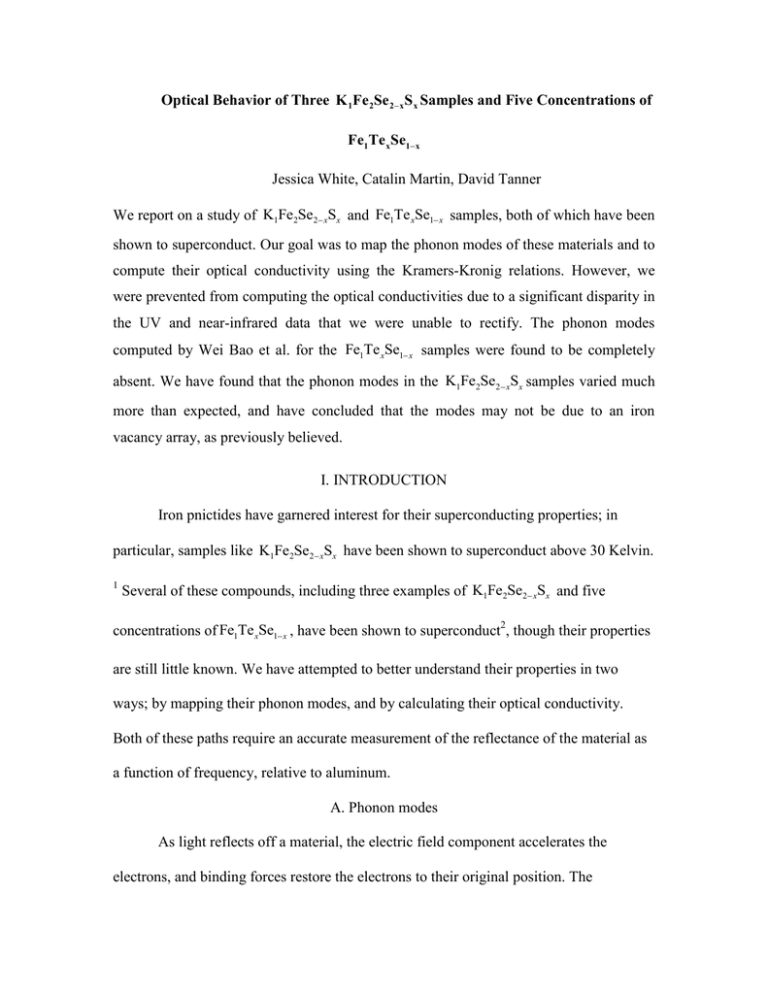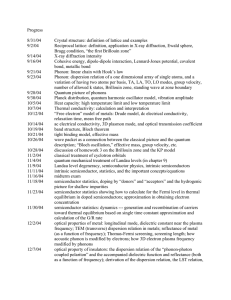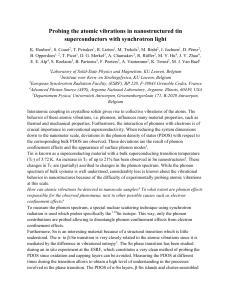Optical Behavior of Three Samples and Five Concentrations of
advertisement

Optical Behavior of Three K 1Fe 2Se 2 xS x Samples and Five Concentrations of Fe1Te xSe1 x Jessica White, Catalin Martin, David Tanner We report on a study of K1Fe2Se2 xSx and Fe1Te xSe1 x samples, both of which have been shown to superconduct. Our goal was to map the phonon modes of these materials and to compute their optical conductivity using the Kramers-Kronig relations. However, we were prevented from computing the optical conductivities due to a significant disparity in the UV and near-infrared data that we were unable to rectify. The phonon modes computed by Wei Bao et al. for the Fe1Te xSe1 x samples were found to be completely absent. We have found that the phonon modes in the K1Fe2Se2 xSx samples varied much more than expected, and have concluded that the modes may not be due to an iron vacancy array, as previously believed. I. INTRODUCTION Iron pnictides have garnered interest for their superconducting properties; in particular, samples like K1Fe2Se2 xSx have been shown to superconduct above 30 Kelvin. 1 Several of these compounds, including three examples of K1Fe2Se2 xSx and five concentrations of Fe1Te xSe1 x , have been shown to superconduct2, though their properties are still little known. We have attempted to better understand their properties in two ways; by mapping their phonon modes, and by calculating their optical conductivity. Both of these paths require an accurate measurement of the reflectance of the material as a function of frequency, relative to aluminum. A. Phonon modes As light reflects off a material, the electric field component accelerates the electrons, and binding forces restore the electrons to their original position. The reflectance of the material increases when the frequency of the light is equal to the resonating frequency of the molecular bonds. The location of a phonon mode indicates a frequency at which a material is most conductive. If the molecular bonds are in a regular array, as in a crystal, these phonon modes will appear sharp and narrow; if the array is less regular, the phonon modes will appear broad and rounded. Phonon modes are sensitive to direction. Light polarized perpendicular to the direction of a possible phonon vibration will not cause the molecular bonds to vibrate. Thus, observing the materials under different polarizations will reveal any anisotropy the materials have. B. Optical conductivity Optical conductivity describes the energies of photon absorption processes in crystals. This function can be used to find the permeability, reflectivity, and absorption constants of a material. This can tell us the skin depth of a metal, and which wavelengths of light are allowed to pass through it. However, we cannot observe optical conductivity directly, as it is a complex function of wavelength. We can only observe the real portion of this function, and measure it as reflectance. The complex portion of the function is calculated using the Kramers-Kronig Relations.3 Since the measured reflectance is equal to the square of its modulus, we have r () R()ei ( ) (1) in polar form, where phi is given by the Kramers-Kronig Relations to be () ln R( ')2 ln2R() d ' 0 ' (2) . In practice, the conversion from reflectance to optical conductivity is done with a computer program. II. INSTRUMENTATION To measure reflectance, we used a Fourier Transform Infrared Spectrometer (FTIR) to measure the far- and mid-infrared spectral ranges, and a Zeiss Microspectrometer to measure the near-infrared and the visual and UV ranges. Both instruments can measure reflectance using polarized light as well. The FTIR can operate with the sample under vacuum, and the sample can be cooled with liquid helium to explore superconducting behaviors. The Zeiss Microspectrometer does not have either of these capabilities. For use in either instrument, the sample mounts are rectangular pieces of copper, with a conical hole drilled into it. This hole can be any size from .25 mm to 6 mm in diameter. The copper allows the sample to be cooled by conduction with liquid helium. These mounts were either placed into the movable sample stage, in the case of the Zeiss, or attached to the end of a flange and inserted into the FTIR. Additionally, an argon etcher was used to coat the samples with aluminum after their initial measurements, so that reflectance could be calculated while accounting for the sample’s surface roughness. III. MATERIALS The K1Fe2Se2 xSx samples were provided by Dr. Petrovic at Brookhaven National Laboratory. These samples are small, about 2 mm in diameter, black, and brittle. Their crystal structure allows them to cleave into flat surfaces, though the fact that they are brittle sometimes makes cleaving difficult. The potassium content makes the samples oxidize quickly, so fresh surfaces do not remain useful long. 3 1 4 2 Fig 1 – Two samples and two sample mounts. (From the left) 1)A sample. 2) A sample. 3) A copper sample mount. 4) A sample mount after being coated with aluminum. A ruler is also pictured, for scale. The K Fe Se S sample is darkened by oxide, while the Fe Te Se sample is clean and shiny. The 1 2 2x 1 x x 1 x aluminum coated mount is shown with the screws that allow it to be used in the FTIR, while the uncoated mount is shown in the configuration that will allow use in the Zeiss. The Fe1Te xSe1 x samples came from Dr. Mao at Tulane University. As shown in Fig. 1 they are larger than the K1Fe2Se2 xSx samples, as much as 6 mm across, and are a bright silver color. Samples with higher selenium content tend to be grainier than lower concentrations, and are harder to cleave neatly. We tested samples with selenium concentrations of 12%, 25%, 30%, 40%, and 45%. IV. METHOD The K1Fe2Se2 xSx samples were initially stored in an argon environment, while the Fe1Te xSe1 x samples were kept in a vacuum desiccator. To measure the reflectance of the K1Fe2Se2 xSx samples, great care was first taken to prepare the instrument and to prepare the area where the sample would be cleaved and mounted. Once the sample was out of the glovebox, we cleaved it using a razor. This was made difficult by the brittle nature of the samples, which would sometimes shatter rather than cleave. We examined the surface to be sure it was suitable, and aligned the crystal with the sample holder. Then the sample was glued to the back of the sample mount with the cleaved face to the front using Elmer’s Liquid Cement. If we were planning to cool the sample to superconducting temperatures, we used G. E. Varnish instead of the liquid cement, because it breaks at low temperatures. We aimed to have the sample out of its argon environment, cleaved, and into vacuum in less than ten minutes if we were using the FTIR. Since the sample would be exposed to atmosphere the entire time if being measured by the Zeiss, we had to take a limited amount of near-infrared and UV data. After the data were taken, the samples and their mounts were retrieved from the instruments, and placed into the etcher machine, which would coat them with about 3000 angstrom of aluminum. The coated samples were then measured again, under the same polarizing settings as the sample. The samples were often discarded after use, since they were usually too thin to cleave again and too oxidized to measure further. The Fe1Te xSe1 x samples were not as difficult to handle, as they were more flexible and did not oxidize. These we cleaved using 3M adhesive tape. The tape would peel off a thin layer of material, leaving a flatter surface behind. The same process as above was used to attach the samples to the copper mounts, and measure them. Also as before, the samples were coated after their initial measurements, and measured again. These samples were usually retrievable, with their aluminum coating peeled off with another application of 3M tape. We measured the full spectral range on all samples. In addition, we measured the K1Fe2Se2 xSx samples while cooled to see if the phonon modes would shift with temperature. In an effort to see if the phonon modes exhibited any anisotropy, we also ran tests at various temperatures while polarizing the incoming light and changing the angle of the polarization. We observed the sample at 0, 22.5, 45, 67.5, and 90 degrees of polarization as well as without the polarizer at room temperature. Additionally, we measured without polarization and at 0, 45, and 90 degrees of polarization at 18 K and 100 K. After the raw reflectance data and the reflectance of the coated samples were taken, we divided sample data by aluminum coated sample data. This yields the reflectance of the sample compared to aluminum, but also takes into account the sample surface’s own roughness. Dividing by an ideally flat aluminum mirror would yield an erroneously low reflectance function of the sample, but the coating method corrects this. These data could then be examined for the peaks that indicate phonon modes. To calculate the optical conductivity of a sample, we collect the material’s reflectance versus frequency, and then apply a program that calculates the complex portion of the reflectance using the Kramers-Kronig Relations, and from there, computes the optical conductivity. However, the Kramers-Kronig Relations require that the reflectance cover all frequencies, from zero to infinity. Since our instruments have a lower limit of about 40 wave numbers and an upper limit of 50,000 wave numbers, we had to extrapolate on either side of the measured data. Fortunately, the reflectivity of metals follows a well known model, the Drude Model.4 Fig.2 – The Drude Model. This figure shows the reflectance of metals, which starts at 1 in the lower wave numbers, and suddenly drops at the plasma frequency. The reflectance approaches zero as the wave numbers approach infinity. As shown in Fig. 2, the reflectance of a metal is approximately one at low wave numbers, drops suddenly at its plasma frequency, then remains a low constant past 45,000 wave numbers. Our materials have a more complicated shape, but still obey these extrema behaviors, allowing us to extrapolate data, and thus to calculate the optical conductivity. V. RESULTS A. Optical conductivity For all samples there was a large disparity in the reflectance in the UV and nearinfrared range spectral ranges, such as the one shown in Fig. 3. Fig. 3 – Disparity in relative intensity of K Fe Se S batch three. The UV and near-infrared data 1 2 2x x disagree, jumping from a reflectance of ~.1 to ~.2 near 650 wave numbers. This disagreement causes difficulties in computing the optical conductivity. To calculate an accurate optical conductivity, we needed to rectify this disparity. In a data manipulation program, we could multiply either the UV or the near-infrared range by a constant, so that they would agree where the ranges overlap, then run the data through the optical conductivity program. To be thorough, we tried both of these options for several samples and compared the results. The two resulting optical conductivity functions for any one sample did not agree sufficiently. We were therefore unable to calculate a credible optical conductivity for any of our samples. B. Phonon modes of Fe1Te xSe1 x K. Okazaki et al. have calculated the theoretical phonon modes of Fe1Te xSe1 x as being at 227.4 cm1 , 247.5 cm1 , 290.9 cm1 , and 302.8 cm1 .2 However, we did not find any of these phonon modes as shown in Fig. 4. . Fig. 4 – The reflectance of the Fe Te Se samples. From top to bottom, the samples contain 30%, 40%, 1 x 1 x 25%, 12%, and 45% selenium. Phonon modes would appear as peaks, but none are present. The sinusoidal noise is caused by interference patterns from the Mylar filters used to collect the data. C. Phonon modes of K1Fe2Se2 xSx The phonon modes this sample type did not seem to shift with temperature, as shown in Fig. 5, but only sharpened as the background noise was lowered. Figure 6 illustrates that the samples did seem to show some anisotropy as the polarization of the incoming light was varied, but not much. Fig. 5 – Reflectance versus wave number for batch one of samples, at various temperatures. The different line colors are various polarizations, and show some small anisotropy. The phonon modes do not shift, but only become somewhat sharper, as background noise from other energy processes is cooled away. The reflectance of the samples at lower temperatures appears to be more than that of an aluminum coating. This is untrue, and results from having not cooled the coated sample. This error is harmless however, since we are interested in whether the phonon modes had changed their location in the spectrum. Fig. 6 – Anisotropy for batch three of the K Fe Se S samples. The different colored lines indicate 1 2 2x x different polarizations; blue for 0 degrees, red for 22.5, green for 45, black for 67.5, and pink for 90 degrees. In general, the 0 degree polarization yielded the greatest reflectance, and 90 degrees the least. This is sometimes obscured by noise, especially in the higher wave numbers. The phonon modes were different for each sample, which was somewhat surprising. Wei Bao et al. have stated that the phonon modes of potassium iron selenides are caused by a regular array of iron vacancies in the crystals.5 Since our samples are similar, and have a constant percentage of iron, the phonon modes caused by such vacancies should be present in out samples. However, these three samples phonon modes vary from sample to sample, instead of remaining constant as expected. As shown in Figs. 7, 8, and 6, respectively, the phonon modes that we have found for each sample occur at 70, 250 and 310 wave numbers for batch one, 210, 220 and 245 wave numbers in batch two, and 300 and 330 wave numbers in batch three. Fig. 7 – The reflectance of batch one. Phonon modes are apparent at 70, 250 and 300 wave numbers. The sample appears to be a weak semiconductor, with a band gap of about 25meV. Fig. 8 – Reflectivity of batch two. Phonon modes are visible at about 220 and 245 wave numbers. The sinusoidal noise is caused by interference patterns from the mylar filters used to collect the data. It should be noted that batch two was more difficult to process than the others. These samples oxidized quickly, becoming unusable within an hour, but this sample in particular oxidized still faster; from a freshly cleaved surface to a dull one in a matter of minutes. Additionally, the surface would not take the aluminum coating after being measured. All data presented for the reflectance of batch two is with respect to an aluminum mirror for this reason. The sample’s reflectance is quite noisy, and it is difficult to find its phonon modes. V. Discussion We were unable to calculate the optical conductivity of any of our samples. In the case of the K1Fe2Se2 xSx samples, we believe this is caused by the quick oxidization skewing the near-infrared and UV data. This cannot be the case for the Fe1Te xSe1 x samples, which do not have this property. It may be that the samples require more care when being placed in the Zeiss, which may be sensitive to the inclination of the sample. If a small change in angle of the sample causes large changes in the detected reflectance, then this may be the cause of the disparity. We were unable to confirm K. Okazaki et al.’s calculated phonon modes through FTIR spectroscopy; in fact, we did not see any phonon modes at all. Wei Bao et al. have claimed that the phonon modes of samples similar to the K1Fe2Se2 xSx samples we used are caused by an array of iron vacancies, about one in every 5 iron molecules missing. If this were the case, our observed phonon modes would not vary the way they do since our samples supposedly have a constant iron percentage. Therefore, we conclude that either the phonon modes are not caused by these iron vacancies or our samples do not contain constant iron content, as we had supposed. Additionally, it appears that batch one is a very weak semiconductor, with an energy gap of about 25 meV, compared to silicon’s 1.17 eV6, and germanium’s .7 eV7 Batch three behaves much more like a metal; with a reflectance starting high at low frequencies and suddenly dropping, it follows the Drude model much more closely. It is unclear whether batch 2 behaves more like a semiconductor or a metal. VI. ACKNOWLEDGEMENTS The authors would like to thank Dr. Petrovic from Brookhaven National Lab and Dr. Zhiqiang Mao of Tulain University for providing the samples we measured, as well as the NSF and Department of Energy for funding. VII. REFERENCES 1 R. H. Yuan, T. Dong, Y. J. Song, G. F. Chen, J. P. Hu, J. Q. Li, and and N. L. Wang, . 2 K. Okazaki, S. Sugai, S. Niitaka, and H. Takagi, Physical Review B 83, 35103 (2011). 3 D. Krcho, in The 3rd Biennial Engineering Mathematics and Applications Conference, Adelaide, Australia, 1998), p. 7-27-11. 4 M. Dressel, G. Grüner, and G. Grüner, Electrodynamics of solids: optical properties of electrons in matter (Cambridge University Press, Cambridge, 2002), p. 474. 5 Wei Bao, Q. Huang, G. F. Chen, M. A. Green, D. M. Wang, J. B. He, X. Q. Wang, and Y. Qiu, A Novel Large Moment Antiferromagnetic Order in K0.8Fe1.6Se2 Superconductor, 2011. 6 J. Gryko and O. Sankey, Physical Review B 51, 7295 <last_page> 7298 (1995). 7 S. E. Dann, Reactions and characterization of solids (Royal Society of Chemistry, Cambridge, UK, 2000), p. 201.







